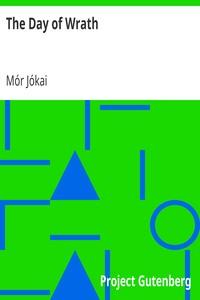Read this ebook for free! No credit card needed, absolutely nothing to pay.
Words: 85077 in 47 pages
This is an ebook sharing website. You can read the uploaded ebooks for free here. No credit cards needed, nothing to pay. If you want to own a digital copy of the ebook, or want to read offline with your favorite ebook-reader, then you can choose to buy and download the ebook.


: The Day of Wrath by J Kai M R Bain R Nisbet Robert Nisbet Translator - Hungary History Uprising of 1848-1849 Fiction
PREFACE
"Szomor? Napok" was written in the darkest days of Maurus J?kai's life, and reflects the depression of a naturally generous and sanguine nature bowed down, for a time, beneath an almost unendurable load of unmerited misfortune. The story was written shortly after the collapse of the Magyar Revolution of 1848-49, when Hungary lay crushed and bleeding under the heel of triumphant Austria and her Russian ally; when, deprived of all her ancient political rights and liberties, she had been handed over to the domination of the stranger, and saw her best and noblest sons either voluntary exiles, or suspected rebels under police surveillance. J?kai also was in the category of the proscribed. He had played a conspicuous part in the Revolution; he had served his country with both pen and sword; and, now that the bloody struggle was over, and the last Honved army had surrendered to the Russians, J?kai, disillusioned and broken-hearted, was left to piece together again as best he might, the shattered fragments of a ruined career.
No wonder, then, if to the author of "Szomor? Napok," the whole world seemed out of joint. The book itself is, primarily, a tale of suffering, crime, and punishment; but it is also a bitter satire on the crying abuses and anomalies due to the semi-feudal condition of things which had prevailed in Hungary for centuries, the reformation and correction of which had been the chief mission of the Liberal Party in Hungary to which J?kai belonged. The brutal ignorance of the common people, the criminal neglect of the gentry which made such ignorance possible, the imbecility of mere mob-rule, and the mischievousness of demagogic pedantry--these are the objects of the author's satiric lash.
R. NISBET BAIN.
THE DAY OF WRATH.
THE BIRD OF ILL-OMEN.
Whoever has traversed the long single street of H?tfalu will have noticed three houses whose exterior plainly shows that nobody dwells in them.
The first of these three houses is outside the village on a great green hill, round which the herds of the village peacefully crop the pasture. Only now and then does one or other of these quiet beasts start back when it suddenly comes upon a white skeleton, or a bleached bullock-horn, in the thickest patches of the high grass. The house itself has no roof, and the soot with which years of heavy rains have bedaubed the walls, points to the fact that once upon a time the place was burnt out. Now, dry white stalks of straw wave upon the mouldering balustrades.
The iron supports have been taken out of the windows, on the threshold thorns and thistles grow luxuriantly. There is no trace of a path--perhaps there never was one.
The land surrounding this house is full of all sorts of fragrant flowers.
The second house stands in the centre of the village, and was the castle of the lord of the manor. It is a dismal wilderness of a place. A stone wall, long since fallen to pieces, separated it at one time from the road. Now only a few fragments of this wall still stand upright, and the wild jasmine creeps all over it, casting down into the road its poisonous dark red cherries. The door lolls against its pillars, it looks as if it had once upon a time been torn from its hinges and then left to take care of itself. The house itself, indeed, is intact, only the windows have been taken out and the empty spaces bricked in. Every door, too, has been walled up, boards have been nailed over the ventilators in the floor, the white stone staircase leading up to the hall has been broken off and propped up against the wall, and the same fate has befallen a red marble bench on the ground floor.
Here and there the cement has fallen away from the front of the house, and layers of red bricks peep through the gap. In other places large heaps of white stone are piled up in front of the building. In the rear of it, which used to look out upon a garden, it is plain that a good many of the windows have also been built in, and, to obliterate all trace of them, the whole wall has been whitewashed. All round about many fruit-trees seem to have been rooted up, and for three years running, the caterpillar-host has fallen upon the remnant; nobody looks after them, and they are left to perish one by one, consumed by yellow mould.
Free books android app tbrJar TBR JAR Read Free books online gutenberg
More posts by @FreeBooks


: Lectures on Architecture and Painting Delivered at Edinburgh in November 1853 by Ruskin John - Painting; Architecture; Turner J. M. W. (Joseph Mallord William) 1775-1851; Pre-Raphaelitism Architecture; Art







